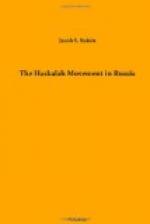of mongrel beliefs. “In no land,”
says Tobias Cohn, “is the practice of summoning
up devils and spirits by means of the Cabbalistic abracadabra
so prevalent, and the belief in dreams and visions
so strong, as in Poland."[8] All this, though it strengthened
religious fervor in some, undermined it in others.
Sects came into being, struggled, and, having brought
added misery upon their followers, disappeared.
Jewish criminals escaped justice by invoking the power
of the Catholic priesthood and promising to become
converted to Christianity.[9] And now and then even
Talmudists left the fold, as, for instance, Carl Anton,
the Courland pupil of Eybeschuetz, who became professor
of Hebrew at Hamsted, and wrote numerous works on
Judaism. Others hoped to win the favor of the
Gentiles by preaching a mixture of Judaism and Catholicism.
In many places, especially in the Ukraine, the seat
of learning that had suffered most from the ravages
of the Cossacks, the state of morals sank very low,
owing to the teaching of Jacob Querido, the self-proclaimed
son of the pseudo-Messiah Shabbatai Zebi, “that
the sinfulness of the world can be overcome only by
a super-abundance of sin.” This paved the
way for the last of the long list of Messiahs, Jacob
(Yankev Leibovich) Frank of Podolia. His experiences,
adventures, and hairbreadth escapes, his entire career,
beginning with his return from his travels in Turkey,
through his conversion to Catholicism (1759), to the
day of his death as “Baron von Offenbach,”
would furnish material for a stirring drama. As
if to counteract this demoralizing tendency, a new
sect, known as Hasidim, originating in Lithuania and
headed by Judah Hasid of Dubno and Hayyim Malak, taught
its devotees to hasten the advent of the Messiah by
doing penance for the sins of Israel. They were
so firmly convinced of the efficacy of fasts and prayers
that they went to Jerusalem by hundreds to witness
the impending redemption (ab. 1706). But the ascetic
Hasidim and the epicurean Frankists were alike doomed
to disappear or to be swallowed up by a new Hasidism,
combining the teachings and aspirations of both, the
sect founded by Israel Baal Shem, or Besht (ab. 1698-1759),
and fully developed by Bar of Meseritz and Jacob Joseph
of Polonnoy.
[Illustration: ISAAC BAeR LEVINSOHN, 1788-1860]
Time was when all writers on the subject, usually
Maskilim, thought it their duty to cast a stone at
Hasidism. They described it as a Chinese wall
shutting the Jews in and shutting the world out.
It is becoming more and more plainly recognized and
admitted, that it was, in reality, an attempt at reform
rendered imperative by the tyranny of the kahal, the
rigorism of the rabbis, the superciliousness of the
learned classes, and the superstition of the masses.
Its aim was to bring about a deep psychologic improvement,
to change not so much the belief as the believer.
It insisted on purity rather than profundity of thought.
Unable to remove the galling yoke, it gave strength
to its wearers by prohibiting sadness and asceticism,
and emphasizing joy and fellowship as important elements
in the fabric of its theology.




